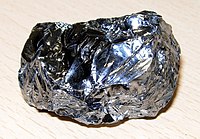
Photo from wikipedia
Abstract In a search of high capacity anode for lithium ion batteries, nano architecture silicon appears as an interesting material despite of its volume change issues. Herein, we report phosphorous… Click to show full abstract
Abstract In a search of high capacity anode for lithium ion batteries, nano architecture silicon appears as an interesting material despite of its volume change issues. Herein, we report phosphorous doped (n‒type) nanocrystalline silicon using plasma enhanced chemical vapor deposition technique exhibiting superior electrochemical performance. Systematically optimized as grown nanocrystalline silicon shows better electrical conductivity of 35 S cm−1. As anode for lithium-ion storage, nanocrystalline silicon exhibits initial discharge capacity of 3090 mAh g−1 at C/5 rate and retains around 2250 mAh g−1 after 50 cycles. Moreover, it displays high rate capability, viz., at 1C rate it delivers an initial discharge capacity of 1830 mAh g−1 with 70% capacity retention after 250 cycles. At 5C (21 A g−1) rate, discharge capacity greater than 650 mAh g−1 with good cycling stability (65% capacity retention) for 500 cycles. The enhanced capacity retention and high rate performance is attribute to unique nanoarchitecture where silicon nanocrystallites are entrench in amorphous silicon matrix. Besides, phosphorous doping improves the electronic conductivity while restricting the volume change by limiting lithium reactivity and phase transition. Hence, n-type silicon thin film comprising highly conducting nanocrystalline islands embed in amorphous silicon matrix is suitable for high power Li-ion battery applications.
Journal Title: Electrochimica Acta
Year Published: 2020
Link to full text (if available)
Share on Social Media: Sign Up to like & get
recommendations!